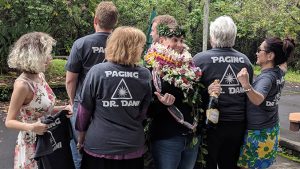
On May 9, 2017, Dani Atkinson lay on a highway near Pepeʻekeo, Hawaiʻi Island, fighting for her life. A driver had stopped suddenly in front of her motorbike, causing her to crash into the back of that vehicle. Exactly one year later, she stood in front of her peers and supporters in Hilo and presented her dissertation that would earn her a PhD in astronomy. “The dissertation thing was tough,” she said. “But it wasn’t much compared to sitting in the hospital for 100 days. The snacks here are better, though.”
Atkinson’s sense of humor and determination, along with the strong support of her family, colleagues and friends, contributed to her amazing recovery and transition into her next phase of life. In June, she begins a postdoctoral fellowship at NASA Goddard Space Flight Center in Maryland, a position that was held for her while she recuperated. The extent of Atkinson’s injuries included major internal trauma and severe damage to her right leg. She spent more than three months at Queen’s Medical Center in and out of the ICU. More than 20 surgeries later, she would spend the remaining part of that challenging year in rehabilitation in Honolulu and in Oregon, where her family lives.
Her advisor and mentor is Don Hall, former director of the University of Hawaiʻi Institute for Astronomy (IfA) and currently an astronomer with the IfA. While Atkinson’s family and friends provided physical and emotional support, Hall was instrumental in keeping Atkinson’s career on track. “Don helped me a lot,” recalled Atkinson. “He not only visited me in the hospital but came to my house (in Oregon) while I was recovering on three occasions to work through details on the papers I was getting published. Don cleaned up a lot of the things that the accident left hanging for me.”
Atkinson’s research investigation focused on the characterization and optimization of near infrared (NIR – 1 to 5um) astronomical detectors, specifically the SAPHIRA 320 x 256 @24um pitch Mercury Cadmium Telluride avalanche photodiode array. Much of her research was tested in labs and at telescopes on Maunakea, and results discussed in her papers will enhance a wide range of astronomical observations, including the hunt for other habitable planets.
A first for Hilo

While she earned her PhD from UH Mānoa, Atkinson is the first graduate student at the IfA to complete all her research and dissertation defense in Hilo. “This milestone highlights the reason graduate students want to come to Hilo to complete their work,” says Mark Chun, associate director, IfA Hilo. “The advantages of the combined resources of the telescopes, with the large community of astronomers, engineers and educators from the different observatories and from UH Hilo—it’s a great environment for early-career scientists.” There are currently six IfA graduate students working to complete their PhDs in Hilo.
While Atkinson doesn’t remember much of those first few months after the accident, she is thankful for the support of many who came to her aid. The driver of the vehicle she hit fled the scene, but a few people who witnessed the accident stayed with her until the ambulance arrived. IfA Hilo’s administrative support specialist, Pamela Lau, provided assistance for Atkinson’s family as they spent the year traveling between Oʻahu, Hilo and the mainland.
It’s been a long and difficult year for Dr. Dani, as she refers to herself nowadays, but she has her sights set on contributing to new and important discoveries in the field of astronomy. “I’m excited to work on this country’s future space telescopes, to push the boundaries of human knowledge,” she says. “I’m very lucky to have gotten this far.” Whether in personal or astronomical terms, it is far indeed.

